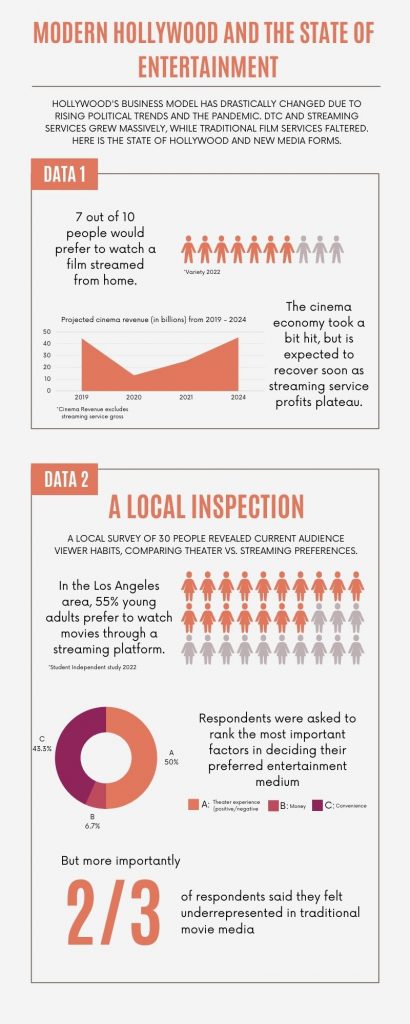The Hollywood sign and stars have always represented Los Angeles as the entertainment capital of the world. The city boasts multiple movie studios, and is home to many production companies.
But the tides are shifting.
The rise of movements like #Oscarssowhite and #Metoo have revealed Hollywood’s lack of diversity and divulged years of sexual misconduct from Hollywood executives, forcing major studios and award shows to change their policies to become more inclusive and transparent. COVID-19 has also damaged the entertainment industry, forcing even more changes. Social distancing mandates and quarantines shut down theaters worldwide, so both studios and audiences had to rely on streaming services to keep creating and consuming entertainment.
A Declining Era and its Successor
The pandemic is partly to blame, but traditional television and film mediums have been steadily losing audience viewership since 2014. This trend has also affected film award shows like the Oscars and Emmys, which have been indicators of an audience’s faith and interest in popular film culture. Nielsen data showed that viewership for the Oscars dropped 6 million viewers from 2019 to 2020 (pre-COVID). In the most recent televised ceremony, viewership dropped half, with only 10 million viewers. With these observations, it looks like Hollywood (and entertainment in general) is following the way of newspapers – increased funding into digital application and less into the physical mediums.
Since media companies shifted to digital journalism, most of them have adopted the subscription and membership model, requiring audiences to pay a monthly fee to access content. The New York Times reported having 7.6 million digital subscribers, and the numbers are rising significantly each quarter. The paywall distribution method is working, and its success has reached the attention of movie and studio executives.
The media fallout has also affected the world of broadcast journalism, as media companies, especially large conglomerates, are shifting money and resources away from local outlets, instead focusing on national media and television shows. Discovery Inc., an emerging conglomerate that just announced its merger with WarnerMedia, follows this business practice and hardly ever invests back into its affiliate stations.
“The company doesn’t see the local stations as profitable anymore. If it makes money, then that money is directed to the [main] company, but if it doesn’t, they won’t put in any money to improve or save the station,” said Meghan Ballantyne, vice president of domestic distribution at Discovery Inc.
There seems to be parallels between the business models of the journalism and movie industry as movie studios like Paramount are projected to spend $6 billion on streaming by 2024. Disney has decreased funding for 20th Century Fox productions in 2019, and freed more liquidity for streaming products. Companies are changing the way that they invest in film and entertainment, diverging from the traditional definition of movie experiences, and it’s beginning to show in public events like the Academy Awards.
“For the first time in history, a streaming movie won Best Picture at the Oscars…I thought Coda was fantastic, but it’s nerve wracking because you begin to lose the definition of movie,” said Ellene Miles, a Academy Awards voting member and the Senior Vice President of Global Marketing at Sony Pictures.

The 2022 Oscars saw a little bit of rebound with 15 million viewers, but it was still the second worst rated Academy broadcast in history. Even with Will Smith and Chris Rock’s onstage feud, and social media to fan the flames, the award show received minimal coverage from an international audience. The show had also cut out eight categories from its primetime showing, further damaging the faith and value that people had in the show’s ability to recognize outstanding films.
Despite all of these issues, the Academy Awards made one move that further solidified the place that streaming platforms have in modern Hollywood. CODA (2021) (created by Apple TV+) was nominated and won Best Picture, making it the first film created by a streaming service to win the show’s most important award. Netflix also had two in-house movies, Don’t Look Up (2021) and Power of Dog (2021), nominated for the same Academy Award category. For the first time in history, mainstream Hollywood was recognizing films outside of the inner circle of traditional studio executives.
The Streaming Ecosystem and its success
Thanks to these developments in human cultural standards and what we deem as important, companies like Netflix, Hulu, YouTube and more have successfully redefined the film and television industry. Nearly 60% of Americans are streaming, and even tech companies like Apple and Amazon have invested millions into their own streaming platforms (Apple TV+ and Amazon Studios). Traditional movie studios have also adapted to the new streaming model, hoping to make money even while the pandemic continued. Shang-Chi is an example of this experiment, as it was Disney’s attempt to see if audience’s would respond well to in-person theaters, as opposed to digital at-will streaming format.
However, COVID-19 is the greatest reason for the sudden popularity of streaming platforms. With mandated quarantine and a sudden influx of freetime, people took the opportunity to consume more entertainment, with streaming services reaching a total of 1.1 billion subscribers by 2021. At an all-time high, 55% of U.S. adults were subscribed to at least one streaming platform – the sudden influx of membership and cash allowed these services to drop more money on scaling tech and production.
To put things into a digestible perspective, I conducted a survey of teens and adults in the surrounding Los Angeles community, asking them to log their theatrical viewing and streaming habits. In that survey (which reached about 30 individuals), I found that around 17 audience members preferred to watch movies through streaming services. According to the survey, the biggest reason for the streaming services success is convenience, allowing audiences to access content from anywhere, especially during the pandemic and its outdoor travel restrictions.

The Cultural Value of Movies and Film
Streaming platforms have become popular due to accessibility during the pandemic, but that’s not the only reason for its growth. Jenae Talison, a film enthusiast and mass communications major at Tennessee State University, says that streaming offers much more diverse content, both in terms of storytelling and casting.
“There’s a lot more freedom for filmmakers to create whatever they want…like Netflix just buys up independent companies and publishes anything with a decent plot line,” Talison explained.
Talison said that she has seen more representation of POC and LGBT+ characters through streaming than through the traditional movie theater experience. Especially as a black woman, she was excited to see stronger representation and inclusion of black Americans in films like Fatherhood (2021). Audiences who have similar experiences and can identify with the characters are more likely to tune into these shows, eventually staying loyal customers of the streaming platforms.
Diversity in films has traditionally been difficult for Hollywood, as mainstream films were controlled and distributed by the studios, which often limited representation and inclusion to supporting or minor roles. In 2015, the Annenberg Inclusion Initiative found that 71.7% of characters on major film and television series were white, 12.2% were black, and other races all trailing behind. But since the pandemic and the big diversity push from streaming, underrepresented groups are slowly gaining traction.


Meg Smith, an entertainment reporter for the Los Angeles Times, has written and covered the topical moments that led to protesting for increased representation in Hollywood, including the #MeToo movement and the George Floyd killing. She points out that it is not only the big streaming services, but also platforms like Youtube and Spotfiy, that have helped generate buzz towards these forms of discrimination, such as the Catch and Kill docuseries.
“Had that young woman not been there at that street corner in Minneapolis, we would not have seen the George Floyd beating,” Smith said. “Because of streaming and because the barriers for entry have been lowered so that anyone with a smartphone and a camera [has] the capabilities to provide video.”
Activists and underprivileged communities took this chance to raise the issue and it eventually spilled over into mainstream Hollywood, which had been historically white in leadership and casting.
“You had social media people grasping on ##Oscarssowhite, and that sort of bubbled up to make the entertainment companies take notice,” Smith explained. “The entertainment companies had to take that seriously because, you know, they looked around and they recognized that, you know, our executive suites do not reflect America. They’re very white, they’re people of privilege…and so Hollywood was forced to recognize that it had established its own system that really was exclusionary.
Streaming Moves Diversity
The rise of streaming means that audiences are exposed to more genres and foreign content/cultures. It’s not just live action movies – animated movies and television series have become driving forces for diversity and inclusion too. With content coming from around the world, streaming services have amassed a cornucopia of content, naturally creating a diverse film and television library.
Yimin Zhang, an alumna from the University of Southern California’s School of Cinematic Arts, is a VFX artist for The Third Floor Inc, an animation and game design company in Los Angeles, has helped create some of the visual effects seen in Marvel movies like Dr. Strange (2018). He says that he has seen the great strides in animation has taken in diversity, especially with releases like Turning Red (2022) and Encanto (2021), with the latter even winning an Academy Award.
“I think that animation has become so powerful because of its flexibility with storytelling,” Zhang said. “You don’t need to worry about casting the right person either…you just have to make sure that your design fits the character you want…animated TV shows are [particularly] effective because they are great at setting up long storylines that people want.”
Netflix’s Arcane (2021) became so popular that it even beat out Squid Game. Netflix’s release of Squid Game (2021) became an international cultural phenomenon as it entrenched its way into popular culture and redirected attention back onto South Korea’s filmmaking. The company also produced and released Over the Moon in 2020, becoming an indicator of the company’s ambition to dominate the animation industry as well.
According to Jason Reisig, a professor of animation at USC and the former global head of animation at Dreamworks Studios, said that the status of animated movies have changed over the years, turning from kids and family shows to Rick and Morty, which cater towards young adults. Streaming services have capitalized on these animated shows, which are often cheaper in cost and more diverse in content.
“When I first started in animation (1996), there was only really Disney, and they were doing the only feature animation [stories],” Reisig explained. “I think spider verse broke down a lot of walls in, in the perception of what a big budget animated movie could do in the United States. [Animation] can be more targeted towards an audience, you know … every aspect of it allows for more storytelling and different types of stories and different types of looks.”
In the current market, it’s not as important as to who produces the content, as most studio produced films end up on Netflix or another equivalent platform a few months after release. But as major studios continue to scale their own streaming platforms, ownership of IP and long-term distribution plans become key in the new Hollywood.
Diversity in film and streaming’s massive subscriber growth are mutual benefactors and have both benefited from the pandemic and different political movements. It’s still unclear if Hollywood’s traditional film studio business will continue operating with its theater distribution market, as companies are beginning to hit the subscriber plateau. For the first time in 10 years, Netflix has lost 200,000 subscribers, putting a dent on the giant’s ability to continually scale. Former WarneMmedia’s CNN+ also released this year, but was only able to attract around 10,000 daily active users. The entertainment ecosystem is fully saturated with streaming products, and traditional entertainment formats could make a resurgence if given the opportunity.

However, despite these recent losses, the streaming platforms have proven their economic success and their ability to adapt to the desires and trends of an international community.
“It’s really hard to say what the future holds, but what I’m hoping for is that there’s an opportunity for [streaming and studios] to still have success,” Sony executive Miles said. “I just want people to be able to tell their stories … I really want those kinds of movies to have a home somewhere. So if that home is not in theaters, then thank goodness for Apple and Netflix and Amazon.”

